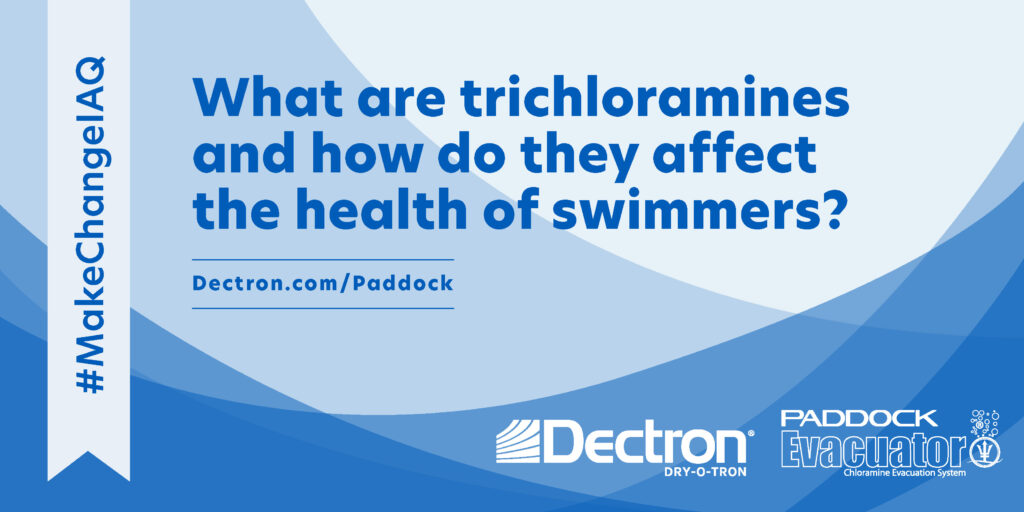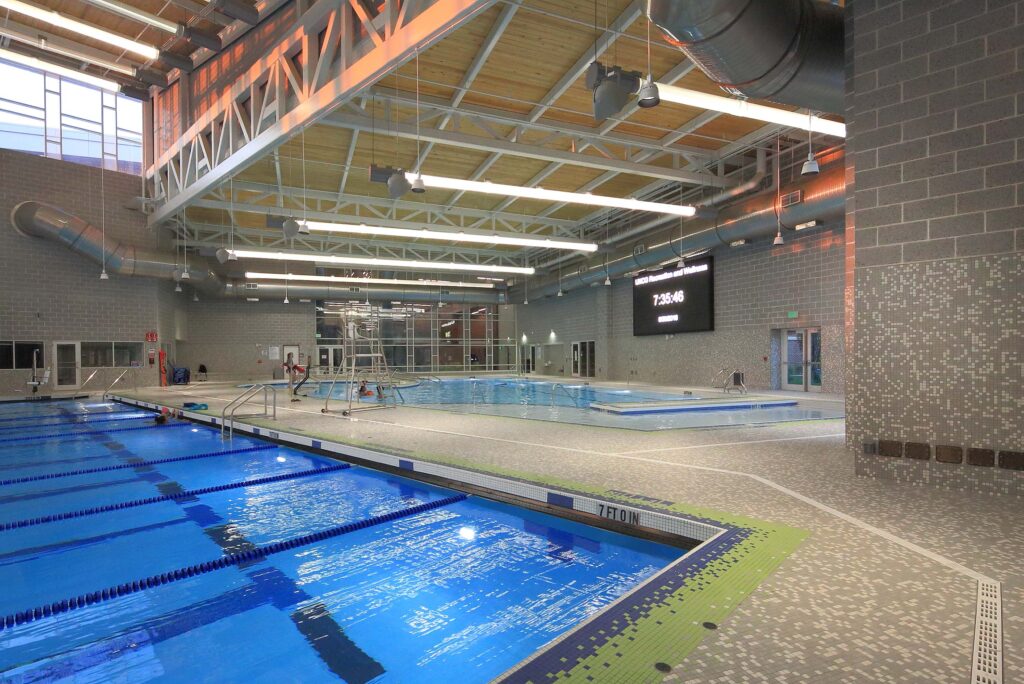
At Dectron, we are often asked about the importance of air movement at the water’s surface and whether this contributes to good IAQ in an indoor pool facility. And it does!
Paddock Pool Equipment Co is helping us provide two children with swim lessons through Step Into Swim for every Dectron unit sold with a Paddock Evacuator®.
Ensuring Paddock Evacuator Technology is included (if it makes sense given the operating conditions and expectations of the facility) when selecting HVAC equipment designed for the facility is a great way to ensure good IAQ from the get-go. In fact, exhaust air is one of four key factors that have the most direct effect on IAQ and are under the design engineer’s control. Read the full article.
Creating the optimal indoor pool environment is no easy feat. There are so many critical considerations that can affect the health and comfort of swimmers and their supporters as well as the structural integrity of the building. Below are three key considerations for facility owners, engineers and contractors striving to create the optimal indoor pool environment. (For a more comprehensive resource, please check out our Natatorium Design Guide). Read the full article.
A message from Rowdy Gaines, 3x Olympic gold medalist and IAQ spokesperson:
Poor IAQ is the bane of competitive swimming and the indoor pool industry.
In competition pools, every time a swimmer comes up for air, you want to ensure the air they’re inhaling is high-quality, clean air. Exposure to poor indoor air quality can make swimmers sick. Temperature and relative humidity play a critical role in human comfort levels and have a direct effect on swimmers’ health.
Check out Chapter Two “Health, Safety, and Comfort” of the Natatorium Design Guide to learn more.
https://lnkd.in/gHQx7ukv
With #MakeChangeIAQ, we hope to change the way people think about the indoor pool environment and ensure more communities have a greater awareness and deeper understanding of the importance of good IAQ. Not only does IAQ affect the health and comfort of the swimmers, but it also affects the communities they’re connected to, particularly their parents and other supporters in the stands, their coaches, the volunteers and facility managers. These communities make up what we like to call the Team Behind the Swim Team.

Providing a healthy, comfortable indoor pool environment through good indoor air quality has long been a challenge for facility engineers and owners, and one key concern regarding air quality is the presence of airborne chloramines. Read our latest article to learn how to control and reduce chloramines to improve IAQ.
When you walk into an aquatic facility—or any other building with an indoor pool—you might notice an odor you think is chlorine and you might even associate it with cleanliness. What you smell though is not chlorine at all, but harmful chloramines. Read the full article.
Paddock Pool Equipment Co is helping us provide two children with swim lessons through Step Into Swim for every Dectron unit sold with a Paddock Evacuator®.
We’re better together. With Paddock’s support, we are not only helping ensure more children learn how to swim, but we are also significantly improving IAQ for swimmers and the Team Behind the Swim Team. Learn more: Dectron.com/Paddock.
Step Into Swim, in partnership with Every Child A Swimmer, is a Pool & Hot Tub Alliance initiative committed to safe swim education and drowning prevention and is run by Rowdy Gaines, 3x Olympic gold medalist and Dectron’s 2022 IAQ spokesperson.
Indoor pool owners play an important role in maintaining good IAQ for swimmers and others who use or work in their facility. Here are a couple of ways owners can ensure good IAQ. Read the full article.

Chlorine is an oxidizing sanitizer added to indoor pool water to keep it clean; it attacks organics in the water, such as hair, skin, urine and saliva. Chloramines, the chemical byproducts of chlorine doing its job, off-gas from the pool water and build up over time. Read the full article.
The indoor competition pool at Queens University in Charlotte, North Carolina, is an excellent example of a successful natatorium environment that has both HVAC and Paddock Evacuator® Technology working to significantly improve IAQ. Download this HPAC Engineering article to learn the design process.
Earlier this year, we announced that Dectron equipment can be built to accommodate Paddock Evacuator® Technology, a source-capture system that pulls trichloramines from the water’s surface and, with the help of HVAC equipment, exhausts them outside the facility to significantly improve IAQ.
Check out the available options and learn more about how the equipment works to improve IAQ for swimmers, their parents and other supporters in the stands, coaches, volunteers and facility managers.
Dectron is now working with Paddock Pool Equipment Co., manufacturer of a full line of innovative pool equipment, to help solve poor IAQ, the bane of competitive swimming and the indoor pool industry in general. Together, the companies offer a solution that will protect the health of swimmers and the integrity of swimming facilities from harmful chloramines.

Chlorine, added to indoor pool water to keep it clean, attacks organics in the water, such as hair, skin, urine and saliva. Many people think when they smell “chlorine” at an indoor pool, it equates to cleanliness, when in fact what they smell is not chlorine at all, but harmful chloramines. Chloramines, the chemical byproducts of chlorine doing its job, off-gas from the pool water and build up over time. Trichloramines, the most volatile of chloramines, are a health hazard known to irritate swimmers’ eyes, skin and respiratory tract. Trichloramines can also cause corrosion to the indoor pool facility.
Dectron equipment can be built to accommodate Paddock Evacuator® Technology, a source-capture system that pulls trichloramines from the water’s surface and, with the help of HVAC equipment, exhausts them outside the facility to significantly improve IAQ. “Paddock Pool Equipment Co., like Dectron, has long been committed to improving indoor air quality and creating the optimal indoor pool environment,” said Mark Hines, Vice President of Sales and Marketing for Paddock Pool Equipment. “By educating builders and their networks on how to improve the long-standing issue of poor IAQ, everyone benefits.”
DECTRON
5685 Rue Cypihot,
Saint Laurent, Quebec
Canada, H4S 1R3
514-336-3330
EXPLORE
© Copyright Dectron
2024. All Rights Reserved.